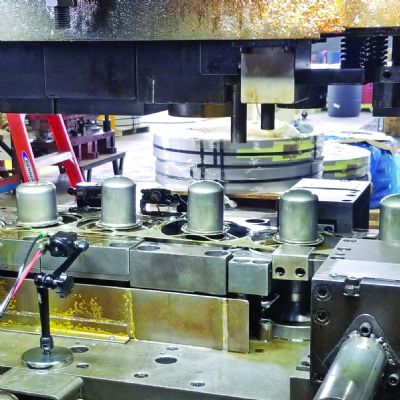Proof-Positive on Prepainted
Testing was expanded to drawing and forming prepainted steel used to make ballast boxes. Orchid found that LS-P-388, used at the same dilution of 17:1, improved wetting and lubricity on painted surfaces compared to the previous lube run at a 10:1 dilution. In fact, since lubricating properties were improved, tests showed that Orchid could reduce the amount of lubricant used by more than 50 percent.
Also tested with the lube: stamping of brackets of galvanized steel and cold- and hot-rolled steels, to 0.90 in. thick. Finally, early in 2006, Orchid’s customers for ballast boxes and brackets approved the change to LS-P-388.
Customer Benefits
In March, 2006, Orchid charged its central mixing station from a tote of the new lubricant, dubbed Lamstamp 3488, allowing the metalformer, for the first time, to feed the same lubricant to all of its presses, mixed at the same dilution. It went with a mix ratio of 15:1 to optimize performance as well as create a cushion for variations in the mix ratio.
After 18 months of using the new lubricant, Orchid noted that the amount of lubricant applied to its dies could be reduced due to the improved lubricating properties of Lamstamp 3488. The health and safety of Orchid’s employees also improved, since application of the previous die lube created a mist in the air around the presses running prepainted steel. Now, thanks to reduced lube consumption with Lamstamp 3488, any residual mist, as well as slippery floors from settling residue, has been eliminated. Lastly, dermatitis, which posed a serious problem with the prior lubricant and required operators to wear special gloves and apply skin creams, also has been eliminated with the new lubricant.
As for production, Orchid has not experienced any issues with its carbide tooling after more than two years of using the new lubricant, while application of lubricant has been reduced to where the lamination stampings exit the presses dry. This gives optimum results for the annealing process but makes it difficult for the stackers to wire the lamination stacks together. Now Orchid applies just enough lubricant to allow the laminations to stick together coming out of the die, making it easier for the stackers to insert the wires.
Part Quality Improved, as are Packaging and Recycling
The ballast boxes stamped from pre-painted steel now run better than ever since the change to Lamstamp 3488, say Orchid officials. The lubricant also has improved part quality by eliminating scratching and water marks on painted parts. Customer complaints about adhesive stickers not sticking have been eliminated. And, the packaging boxes no longer are soaked with lubricant, making for a better-looking product going out the door.
To recycle the lubricant, used die lube is sucked from a pan under each press and is taken to a recycling station were tramp oil is removed and solids filtered out. In the past, the shop mixed two types of lubricants together and then treated the mixture with as many as three different and expensive additives to control microbial growth, pH and corrosion. And then, it could only use the reclaimed mixture on certain dies. Now, only one lubricant—at a much lower volume—is collected and requires the use of only one additive for microbial control. Orchid uses reclaimed Lamstamp 3488 in all of its presses. MF
View Glossary of Metalforming Terms
See also: Tower Metalworking Fluids
Technologies: Lubrication








 Video
Video
